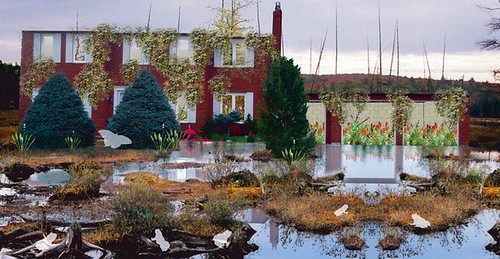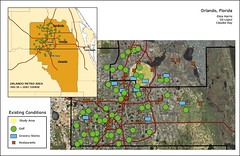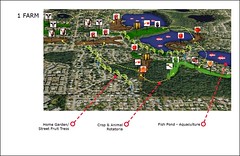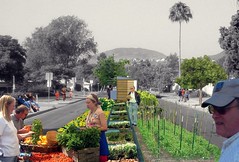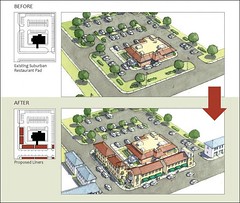The Reburbia project – a very cool suburban design competition

Posted August 12, 2009 at 1:39PM
Dwell Magazine and Inhabitat.com are currently hosting a very fun exercise called Reburbia, a design competition dedicated to re-envisioning the suburbs. As explained on the project's website:
"In a future where limited natural resources will force us to find better solutions for density and efficiency, what will become of the cul-de-sacs, cookie-cutter tract houses and generic strip malls that have long upheld the diffuse infrastructure of suburbia? How can we redirect these existing spaces to promote sustainability, walkability, and community? It's a problem that demands a visionary design solution and we want you to create the vision!"
The deadline for entries has passed, but the site is now displaying the twenty finalists along with another twenty "notable submissions." They range from the very fanciful to the very practical.
In the fanciful and fun category, for example, how about a fleet of airships (submitted by Alexandros Tsolakis and Irene Shamma), an "eco-friendly and efficient transportation system linking the suburbs and city centre," to compensate for the lack of good public transportation infrastructure? Or "Frog's Dream" (submitted by Calvin Chiu & pictured above), a project to turn McMansions into biofilter water treatment plants?
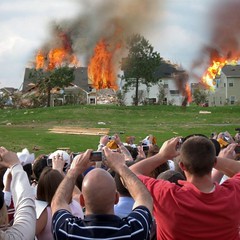 Even more radical is "Let Them Burn" (Nogo Voyages), which proposes to do just that:
Even more radical is "Let Them Burn" (Nogo Voyages), which proposes to do just that:
"In front of the city is a factory that builds the new districts, and behind it, another factory that destructs the older ones. It is an image of the American suburb: its main characteristic is not to sprawl, but to move. Continuously, new suburbs are built, and old suburbs are abandoned (see Detroit) . . .
"These ghost towns sometimes become attractions for tourists, such as the cities of the Gold Rush. The [recession] has accelerated the process.
"For sure, all the vacant developments will not become touristic attractions. We propose to use the other ones for great popular parties, during which the houses will be set to fire one by one . . .
"Let the suburbs die. There is nothing left to do with the territories consumed by residential sprawl."
That's a little extreme, even for my taste. But, if it had been one of the finalists, I might have voted for it anyway, just to honor its boldness.
As you might expect given the trendiness of the idea, there were lots of proposals for converting various aspects of the suburbs to agriculture. Regular readers will know that I'm not a huge fan of that idea, particularly given the expectation of 50 million new American households over the next 25 years, because it will only create more (if prettier) sprawl, forcing more and more of those households beyond the current fringe. But I did kind of like a couple of them, especially one that proposes converting suburban golf courses to agriculture. Designed by Orlando's Claudia Ray-Centeno, the submission for "Links Farm" notes (and shows the location of) over 50 existing golf courses in that metro area that might become candidates for conversion.
Another project along those lines struck me as actually quite compelling: place "new regenerative medians" down the centers of overly wide suburban streets, "that treats gray water and sewage, produces agriculture, provides a platform for small scale commercial activity and slows down automobile traffic to promote increased pedestrian activity and social interaction within the neighborhood." I can imagine a few safety issues with the project, designed by Brian Alessi, but it has a lot going for it.
But perhaps the most pragmatic entry, submitted by Galina Tahchieva of the well-known new urbanist architecture and planning firm Duany Plater-Zyberk, is the one I voted for. The "Urban Sprawl Repair Kit" is, in fact, exactly what many of our suburbs need: artful densification to make them more walkable and sustainable, helping to find places for all those households (and businesses) that we will need to accommodate without continued mindless expansion of suburbia.
Grayfields (mainly excessively large suburban parking lots) represent a tremendous opportunity for accommodating growth and building greener (note the solar panels, green roofs and porous pavement in one of the "after" renderings). Many of the commenters weren't too kind to this one, though, generally because they found it too incremental (its greatest strength, in my opinion), too conventional compared to the flights of imagination submitted by some others or, ironically, too much more building in the suburbs (never mind that without this kind of development, there will be even more building of newer and more sprawling suburbs). It still has proven very popular with the voters.
Really, I've just scratched the surface of what's on this very cool site. Take a look. You can vote for your favorite between now and August 18.
